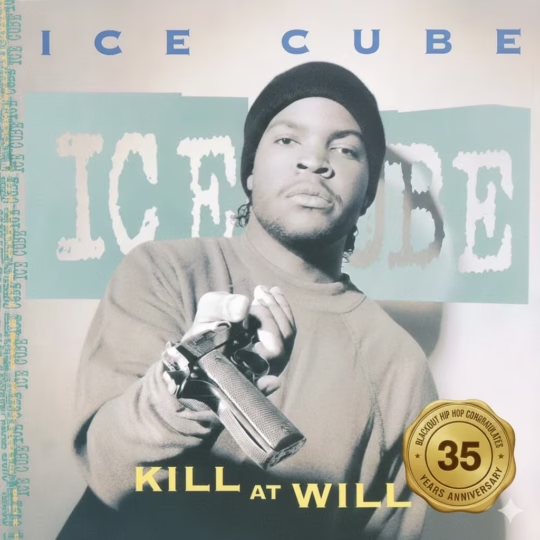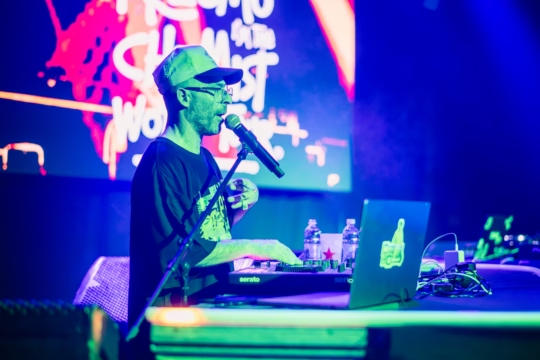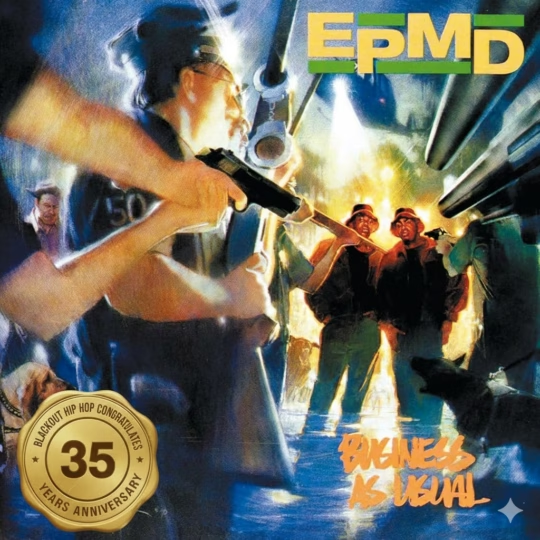What the F@*K Happened to Hip House?

As anyone who watched House Party with Kid and Play as a Saturday Blockbuster rental video in the 90’s before heading out on a Saturday knows, hip house was the genre that exploded as quickly as it died. But what the hell happened to it, and why is it filtering back into house music once again?
Hip house emerged as a straightforward fusion of its two namesake genres: house music’s four-on-the-floor beats and synthesised piano lines combined with the funk and soul samples that hip hop producers favoured, topped with MCs delivering club-ready lyrics. Between 1988 and 1991, these two scenes which had often viewed each other with suspicion found common ground on dancefloors and created something genuinely fresh.
But was hip house really a musical movement, or was it hip hop having an identity crisis? By 1988, house music was exploding out of Chicago, commanding dancefloors worldwide and threatening to eclipse hip hop’s cultural dominance. Were artists like Fast Eddie and the Jungle Brothers genuinely inspired by four-on-the-floor beats, or were they scared that hip hop was being left behind?
The timing suggests something deeper was happening. Just as hip house emerged, a new wave of hip hop artists was actively rejecting the harder edge that would soon dominate the genre. De La Soul’s 3 Feet High and Rising (1989) and Dream Warriors’ playful “Wash Your Face in My Sink” represented a conscious alternative to the increasingly aggressive narratives coming from both coasts. These artists embraced whimsy, positivity, and musical experimentation values that aligned perfectly with house music’s escapist ethos.
The Native Tongues collective featuring De La Soul, A Tribe Called Quest, Jungle Brothers, and Queen Latifah became hip house’s unlikely champions not because they were chasing trends, but because they shared house music’s belief in joy as resistance. Their Afrocentric fashion choices colourful, playful, decidedly non-threatening stood in stark contrast to the leather and gold chains becoming synonymous with hardcore hip hop.
Hip house’s visual identity was as important as its sound. The aesthetic wasn’t about looking hard or street – it was about looking fun. Kid ‘n Play’s signature flat-top hairstyles, Queen Latifah’s African-inspired jewellery, and the Jungle Brothers’ casual, colourful gear represented a deliberate departure from hip hop’s increasingly uniform tough-guy image. These artists dressed for the dancefloor, not the corner.
This wasn’t accidental. As Afrika Baby Bam explains, he was literally moving between scenes: “I used to go from the hip hop clubs when they shut down to house clubs in Lower Manhattan” The fashion reflected this fluidity comfortable enough for b-boying, stylish enough for house clubs, accessible enough for mainstream consumption.
But here’s where things get complicated. Was this crossover genuine artistic evolution, or was it hip hop being sanitised for broader commercial appeal? The success of European hip house acts like Technotronic and Snap suggests that labels saw an opportunity to make black American culture more palatable to white audiences. The vocals became simpler, the politics disappeared, and the edge was smoothed away.
Consider the context: whilst N.W.A. were perfecting gangsta rap’s confrontational blueprint and Public Enemy were delivering militant manifestos, hip house offered a third way. It was black music that celebrated rather than condemned, that invited participation rather than demanded respect. For artists feeling constrained by hip hop’s increasingly narrow definitions of authenticity, house music’s inclusive energy provided liberation.
Doug Lazy captured this perfectly: “When you are in a club, you ain’t paying that much attention to the lyrics back then, anyway – you are just there to have fun” This wasn’t anti-intellectual; it was pro-joy. At a time when conscious rap was becoming more didactic and street rap more violent, hip house maintained hip hop’s original party spirit whilst embracing house music’s communal euphoria.
The Dream Warriors, those Canadian innovators behind “Wash Your Face in My Sink,” exemplified this alternative approach. Their sample-heavy, jazz-influenced style and absurdist humour offered a blueprint for hip hop that prioritised creativity over credibility, fun over fear. They proved that black artists could be intellectual without being serious, political without being angry.
The Fresh Prince Phenomenon
And speaking of cultural ambassadors, we can’t discuss hip house’s visual and cultural impact without mentioning a young Will Smith. As The Fresh Prince of Bel-Air debuted in September 1990, Smith became an unlikely bridge between hip hop’s street credibility and mainstream acceptability. His wardrobe choices perfectly embodied hip house’s aesthetic philosophy: “baggy jeans, brightly colored tees and shirts, equally colorful caps, jumpsuits of all kinds, and Nikes on her feet” clothing that was comfortable enough for b-boying, stylish enough for house clubs, accessible enough for mainstream consumption.
The Fresh Prince represented everything hip house was trying to achieve culturally. Smith’s style, popularised many looks that are still seen today in the new underground house scene in Dalston: dungarees with one shoulder falling off, Jordans, bright matching colours, tracksuits, busy graphic tees and even crop tops. More importantly, his character demonstrated that black masculinity didn’t have to be threatening to be authentic. The show’s fashion “reflected the social dynamics of the time” and was “heavily influenced by hip-hop culture” when the early ’90s saw the rise of hip-hop as a dominant cultural force.
The Whitewash Question
The uncomfortable truth is that hip house’s mainstream success coincided with its cultural dilution. European producers like those behind Technotronic and Snap weren’t engaging with black American culture so much as appropriating its surface elements. The Belgian-produced “Pump Up The Jam” featured a Congolese-Belgian rapper, Ya Kid K, but marketed a fashion model, Felly Kilingi, as the face of the single a decision that epitomised how the industry commodified black creativity whilst erasing black bodies.
This pattern repeated across Europe and eventually America. The lyrics became more generic, the politics evaporated, and the rough edges that made early hip house compelling were smoothed away for mass consumption. Hip house’s commercial peak represented both its greatest triumph and its cultural death the moment when a genuine fusion became a marketing demographic.
Yet the original artists maintain that their work was authentic. As Tyree Cooper insists, “When rappers was rapping to hip house, it wasn’t no corny shit. It wasn’t rhyming corny in the beginning. You was coming with some lyrics, with a style” The question remains: was hip house’s commercialisation an inevitable corruption, or simply the price of black innovation in a white-dominated industry?
The real innovation happened in the dialogue between Chicago and New York. Fast Eddie’s pioneering work at DJ International created the template house music’s mechanical precision meeting hip hop’s human swing. When Todd Terry connected with the Jungle Brothers in New York, they weren’t just making music; they were creating a cultural bridge.
“I’ll House You” became hip house’s defining moment because it captured both scenes’ essence whilst remaining completely authentic to neither. It was house music that hip hop heads could accept, hip hop that house purists couldn’t dismiss. As Afrika Baby Bam recalls, writing it took about 20 minutes: “We actually took the record, put it on the turntable, recorded it to the tape machine, and then did the vocals on top of the record as it is.”
This spontaneity was crucial. Hip house worked best when it felt accidental, when the fusion seemed natural rather than calculated. The moment it became a formula which happened remarkably quickly the magic disappeared.
Hip house’s commercial peak coincided with its rapid decline. The reasons were complex, but the result was swift and decisive. As Doug Lazy observed: “When hip house fell off, it fell, like, Grand Canyon cliff off! It was like, ‘Boom!’ Nobody was really trying to hear it.” The major labels, initially interested in the commercial potential, began pushing artists in directions that compromised the music’s authenticity.
Tyree Cooper identifies the rise of gangsta rap as a key factor: “Everybody was feeling hip house, and it was really starting to feel it in America, until reality rap came. Then everybody wanted to be a gangsta because it looked cool.” The cultural shift was significant. Hip hop was becoming more confrontational and aggressive, whilst house music’s association with gay culture and hedonistic escapism created tensions with rap’s new harder-edged image. As Cooper notes, “They made it look like it was such a gay thing.”
Media played a role too. “Yo! MTV Raps didn’t give it no love,” Cooper recalls. “Mr. Lee was selling everywhere, all around the world, but Yo! MTV Raps wouldn’t play the videos.” Hip house’s decline revealed something profound about black music identity that persists today. The question became stark: are you hip hop or are you electronic? This cultural divide runs deeper than musical preference it’s about authenticity, belonging, and who gets to claim ownership of black innovation.
As one academic observer notes, both hip hop and house “are distinctly Black American artforms that originated on the streets and dance floors” but “house music thrived on inclusivity, served as a safe space for Black and Latino members of the LGBTQ+ communities at a time when hip-hop was severely unwelcoming of gay men.” This fundamental difference in community acceptance created lasting tensions that hip house temporarily bridged.
The divide is particularly stark in Chicago, where both genres originated. Director David Weathersby’s documentary “It’s Different in Chicago” explores how the city remains split between house heads and hip hop fans. “I’ve noticed that, especially within the Black community, we like the music but it also becomes our tribe—the flag that we fly,” Weathersby observes. “The choice between hip hop and house often “boiled down to the culture around each respective music scene rather than the music itself.”
This cultural schism has had lasting effects. As electronic music historians note, “Electronic music is Black history… House, techno, garage, jungle—these weren’t created in a vacuum. They were built by Black artists, DJs, and producers who shaped the underground before the mainstream even knew what to call it. But you wouldn’t always know that from looking at festival lineups or the way the industry frames electronic music today.”
The erasure is systematic: “Techno isn’t ‘Berlin music.’ It’s Detroit music. House didn’t come from Ibiza, it came from Black and Latin clubs in Chicago and New York.” Yet the average electronic music fan often associates these genres with white European DJs, whilst hip hop maintains stronger connections to its black origins.
Musical Transitions: Who Went Where?
The aftermath of hip house’s collapse created interesting career trajectories. Some artists successfully transitioned back to hip hop, others embraced electronic music fully, and a few managed to straddle both worlds. The most successful contemporary example is Kaytranada, the Haitian-Canadian producer who embodies hip house’s original spirit whilst navigating its modern complexities. “Blending the rhythmic thunk, swagger and bump of swung hip-hop beats with the irresistible upbeat club appeal of house music, and a sprinkling of disco magic, he’s arrived at a groove that few others have even thought of,” as one critic observed.
Kaytranada’s approach has been between telling sometimes a story of classic hip-hop usually siting between 85 and 95 beats per minute, while house and techno range between 115 and 130. But Kaytranada represents the exception, not the rule. As contemporary collaborations between DJ Kaytranada and rapper Childish Gambino shows how artists from both genres continue to feed off each other, most artists who love both styles, still face pressure to choose sides. The industry’s structure reinforces this division hip hop operates through different labels, different radio formats, different festival circuits than electronic music.
The contemporary scene shows both progress and persistent divides. Artists like Channel Tres, Black Coffee, and Drake’s house-influenced “Honestly, Nevermind” album demonstrate ongoing crossover potential. But as platforms like SoundCloud “democratized music production, allowing emerging artists to build on the decades of innovations that preceded them,” they’ve also enabled the continued separation of these originally intertwined forms.
Continuing Evolution
Did hip house actually disappear? Not entirely. As Tyree Cooper argues, “Is hip house dead? No. The Black Eyed Peas for the last three, four, five years have been doing hip house – they just don’t call it that.”
Hip house went underground and evolved. Throughout the ’90s and 2000s, artists like Fire Island (featuring Ricardo Da Force), Armand Van Helden collaborating with Common, and Missy Elliott’s 2001 house track “4 My People” maintained the connection. These weren’t always labelled as hip house, but they carried the same fundamental approach combining rap vocals with dancefloor-focused production.
More recently, artists like Channel Tres, Honey Dijon featuring Cakes Da Killa, and Azealia Banks (before personal controversies overshadowed her music) have demonstrated that when hip house is executed well, it retains the same dancefloor appeal that made the original wave compelling. In today’s streaming era with more flexible genre boundaries, hip house’s brief flowering seems ahead of its time. Artists like Kaytranada, MK, and numerous bedroom producers create music that would have been called hip house in 1989 they simply don’t need to use the term because musical categories have become more fluid.
As one observer notes, “We now live in an era where DJs such as Spinna and Snips can be equally revered in both the house and hip hop scenes; where a true house master like Marc Kinchen (MK) can choose to move into hip hop, do so with huge success, then be welcomed back into the house / techno world with open arms.”
Hip house’s legacy isn’t solely musical it’s cultural. It demonstrated that seemingly incompatible genres could coexist and create something valuable. In an era when music scenes often felt tribal and exclusive, hip house offered a vision of the dancefloor as a space of genuine multiculturalism.
Hip house’s main significance may not be its commercial peak, but rather what it represented culturally. These tracks documented “the vibe of their era, when each of the genres was fairly new and full of potential” records from a time when both hip hop and house music felt like they could reshape popular culture, and briefly, together, they almost did.
When you hear Kanye (or X or whatever name he goes by now) incorporating Cajmere’s “Brighter Days” into his Sunday Service, or watch Channel Tres command a festival crowd, you’re witnessing hip house’s ongoing influence. The genre may have lost its name, but it never really disappeared it simply learned to exist within other musical contexts, waiting for the right moment to resurface.



You must be logged in to post a comment.